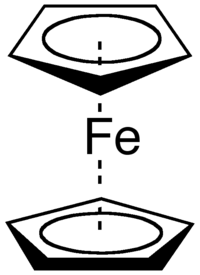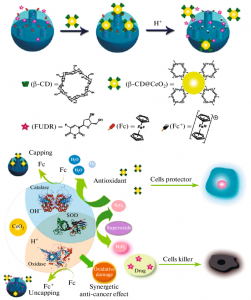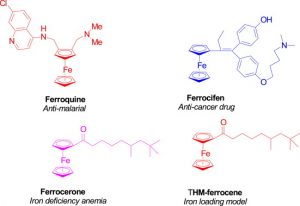Research in medicinal chemistry has been booming in the last few years due to important discoveries made by fellow scientists. Ferrocene which is one of the most famous organometallic structures discovered in the early 1900’s can open many routes in cancer research. The discovery of the first sandwich complex opened a new area of research and since then many similar structures have been synthesized. Wilkinson and Fischer received a Nobel prize in chemistry for their remarkable work in developing sandwich structures using transition metals. A sandwich complex is defined as a metal center connected to aromatic rings. When ferrocene was discovered, its medicinal applications were not known. Recently, Ferrocene and its derivatives have found their way in medicinal chemistry as anti-cancer and HIV agents.

Figure 1: The structure of Ferrocene consisting of an iron metal centered around two aromatic rings. The name sandwich complex comes from the fact that the metal is sandwiched between two molecules.
In order to understand the mechanism behind ferrocene acting as an anti-cancer agent, basic understanding of anti-cancer agents is required. There is an enzyme in the body known as Topoisomerase that keeps the topology of DNA by unwinding the DNA for replication. Tumour cells increase the activity of topoisomerase; thus anti-tumor drugs act by lowering the activity of topoisomerase. Ferrocenium ions get reduced in the cell generating a hydroxyl radical. These radicals are responsible for biological damage in cancer cells. The ferrocenium species target specifically a protein complex that binds to a specific region of DNA. The above mechanism helps in inhibiting the activity of cancerous cells. Damaging the tumor cells responsible for increasing topoisomerase activity helps regulate the activity of DNA.

Figure 2: A detailed mechanism of how Ferrocene and its derivatives get reduced in the cell causing cancerous cells to die
Ferrocene derivatives are also used in regulating HIV virus which is responsible for AIDS. According to recent studies, 75,500 Canadians were living with HIV by the end 2014. The number of Canadians affected by HIV has increased dramatically in the last few years and many scientists are trying to find therapeutic agents that can target HIV. The same enzyme mentioned above known as Topoisomerase is also involved in HIV. Researchers have shown that topoisomerase is involved in HIV replication cycle. Viruses have the tendency to use the cell machinery to replicate and survive inside the body. Ferrocene derivatives are very effective in inhibiting the activity of topoisomerase involved in HIV replication. Some drugs containing ferrocene gave promising results as Anti-HIV agents. These compounds are thought to inhibit the synthesis of viral DNA.

Figure 3: Some common Ferrocene compounds and their use in medicinal chemistry
In Conclusion, organometallic compounds have unique properties that allow them to have wide applications in medicinal chemistry. Attaching ferrocene and its derivatives to biological drugs will serve in increasing the efficiency of drugs. The possibility of using ferrocene in medicinal applications are endless. Hopefully, this powerful class of compounds could find its way to market shelves soon.
By: Tarek El Sayed
